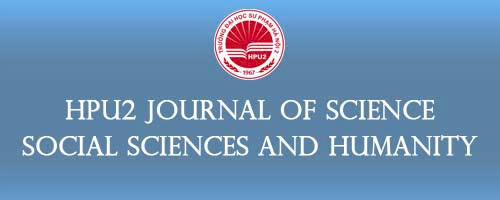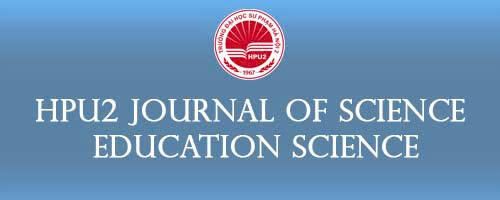Structure, magnetic properties and magnetocaloric effect of \(Fe_{81-x}Cr_{x+4}B_2Zr_{10}Nd_3\) rapidly quenched alloys
DOI:
https://doi.org/10.56764/hpu2.jos.2024.3.2.10-17Abstract
This paper presents, we present the structure, magnetic properties, and magnetocaloric effect of the Fe81-xCrx+4B2Zr10Nd3 (x = 0, 1, 2, and 3) alloy ribbons. The alloy ribbons were prepared by using the melt-spinning method. Structural analysis by X-ray diffraction shows that the obtained alloy ribbons are almost amorphous. Curie temperature of the alloy ribbons decreases from 310 to 275 K when x increases from 0 to 3. Under a magnetic field change of 12 kOe, the maximum magnetic entropy change \(|\Delta S_m|_{\text{max}}\) of the Fe80Cr5B2Zr10Nd3 alloy ribbon is found to be 1.05 J.kg-1.K-1 at 302 K. In addition, the large refrigerant capacity (RC > 80 J∙kg-1 with \(\Delta H=12\) kOe) at room temperature is obtained in the alloy ribbon. Thus, the alloy ribbons can be considered a potential magnetic refrigerant in the room temperature range.
References
[1] V. Franco, J. S. Blázquez, J. J. Ipus, J. Y. Law, L. M. Moreno-Ramírez, and A. Conde, “Magnetocaloric effect: From materials research to refrigeration devices,” Prog. Mater. Sci., vol. 93, pp. 112–232, Apr. 2018, doi: 10.1016/j.pmatsci.2017.10.005.
[2] A. M. Tishin, Y. I. Spichkin, V. I. Zverev, and P. W. Egolf, “A review and new perspectives for the magnetocaloric effect: New materials and local heating and cooling inside the human body,” Int. J. Refrig., vol. 68, pp. 177–186, Aug. 2016, doi: 10.1016/j.ijrefrig.2016.04.020.
[3] N. Tiwari, V. Pal, S. Das, and M. Paliwal, “Proposed compositions in a Ni-Mn-Ga system for magnetocaloric applications,” J. Electron. Mater., vol. 53, no. 4, pp. 1773–1795, Jan. 2024, doi: 10.1007/s11664-023-10882-0.
[4] Yu. S. Koshkid’ko et al., “Magnetocaloric effect and magnetic phase diagram of Ni-Mn-Ga Heusler alloy in steady and pulsed magnetic fields,” J. Alloys Compd., vol. 904, p. 164051, May 2022, doi: 10.1016/j.jallcom.2022.164051.
[5] P. Lázpita, A. Pérez-Checa, J. M. Barandiarán, A. Ammerlaan, U. Zeitler, and V. Chernenko, “Suppression of martensitic transformation in Ni-Mn-In metamagnetic shape memory alloy under very strong magnetic field,” J. Alloys Compd., vol. 874, p. 159814, Sep. 2021, doi: 10.1016/j.jallcom.2021.159814.
[6] T. Bachagha, R. Chakaravarthy, W. Ren, J. Saurina, and J.-J. Suñol, “Structural, magnetocaloric, and magnetic properties in Heusler Ni50Mn35In10X5 (X = Ga, Fe and Al) alloys,” Metals, vol. 13, no. 12, p. 1913, Nov. 2023, doi: 10.3390/met13121913.
[7] Y. Zhang, J. Ouyang, X. Wang, Y. Tian, and Z. Ren, “Magneto-structural transformations and magnetocaloric effect in the Heusler type Ni48Cu2Mn36Sn14-xTix melt-spun ribbons,” Mater. Chem. Phys., vol. 290, p. 126527, Oct. 2022, doi: 10.1016/j.matchemphys.2022.126527.
[8] F. Wang et al., “Effect of sintering temperature on the magnetocaloric effect of Ni-Mn-In/Tb-Dy-Fe composites,” J. Supercond. Nov. Magn., vol. 37, no. 3, pp. 557–563, Jan. 2024, doi: 10.1007/s10948-024-06695-9.
[9] J. Sharma, A. A. Coelho, K. G. Suresh, and A. Alam, “Martensitic and room-temperature magnetocaloric properties of Mn-rich Mn-Ni-Sn Heusler alloys: Experiment and theory,” Phy. Rev. B, vol. 109, no. 6, p. 064418, Feb. 2024, doi: 10.1103/PhysRevB.109.064418.
[10] D. D. Kuznetsov et al., “Magnetocaloric effect, structure, spinodal decomposition and phase transformations Heusler alloy Ni-Mn-In,” Nanomaterials, vol. 13, no. 8, p. 1385, Apr. 2023, doi: 10.3390/nano13081385.
[11] F. Zhang et al., “The second-order magnetic phase transition and magnetocaloric effect in all-d-metal NiCoMnTi-based Heusler alloys,” J. Alloys Compd., vol. 906, p. 164337, Jun. 2022, doi: 10.1016/j.jallcom.2022.164337.
[12] A. L. Li, Q. Wang, B. Z. Tang, P. Yu, D. Ding, and L. Xia, “Magnetocaloric effect of the Fe87M8B5 (M = Zr, Ce) amorphous alloys,” Mater. Sci. Eng. B, vol. 286, p. 116033, Dec. 2022, doi: 10.1016/j.mseb.2022.116033.
[13] Q. Wang, D. Ding, B. Z. Tang, P. Yu, K. C. Chan, and L. Xia, “Excellent magnetocaloric performance of a Fe88Zr4Pr4B4 amorphous alloy and its amorphous hybrids,” Intermetallics, vol. 161, p. 107982, Oct. 2023. doi: 10.1016/j.intermet.2023.107982.
[14] X. Wang, Q. Wang, B. Z. Tang, D. Ding, L. Cui, and L. Xia, “Magnetic and magneto-caloric properties of the amorphous Fe92-xZr8Bx ribbons,” Materials (Basel)., vol. 13, no. 23, p. 5334, Nov. 2020, doi: 10.3390/ma13235334.
[15] B. Biswas, D. Biswas, M. Debnath, E. Bose, and S. Pal, “Giant magnetocaloric effect and second order phase transition in PrMnO3,” J. Magn. Magn. Mater., vol. 588, p. 171445, Dec. 2023, doi: 10.1016/j.jmmm.2023.171445.
[16] X. Li, Y. Pan, and T. Lu, “Magnetocaloric effect in Fe-based amorphous alloys and their composites with low boron content,” J. Non-Cryst. Solids, vol. 487, pp. 7–11, May 2018, doi: 10.1016/j.jnoncrysol.2018.02.022.
[17] D. Guo, K. C. Chan, and L. Xia, “Influence of minor addition of Cr on the magnetocaloric effect in Fe-based metallic ribbons,” Mater. Trans., vol. 57, no. 1, pp. 9–14, Jan. 2016, doi: 10.2320/matertrans.M2015146.
[18] Y. K. Fang et al., “Magnetocaloric effect in Fe-Zr-B-M (M = Mn, Cr, and Co) amorphous systems,” J. Appl. Phys., vol. 105, no. 7, p. 093910, Feb. 2009, doi: 10.1063/1.3054369.
[19] T. D. Thanh et al., “Critical behavior of the ferromagnetic-paramagnetic phase transition in Fe90-xNixZr10 alloy ribbons,” J. Appl. Phys., vol. 115, no. 2, p. 023903, Jan. 2014, doi: 10.1063/1.4861400.
[20] T. L. Phan et al., “Magnetic properties and magnetocaloric effect in Fe90-xSnxZr10 alloy ribbons,” J. Korean Phys. Soc., vol. 66, no. 8, pp. 1247–1252, Apr. 2015, doi: 10.3938/jkps.66.1247.
[21] L. Chen, J. Zhang, L. Wen, P. Yu, and L. Xia, “Outstanding magnetocaloric effect of Fe88-xZr8B4Smx (x=0, 1, 2, 3) amorphous alloys,” Sci. China Phys. Mech. Astron., vol. 61, no. 5, p. 056121, Nov. 2018, doi: 10.1007/s11433-017-9152-7.
[22] W. Yang et al., “Low-temperature magnetic properties and magnetocaloric effect of Fe–Zr–Cu amorphous alloys,” J. Low Temp. Phys., vol. 200, no. 1, pp. 51–61, May 2020, doi: 10.1007/s10909-020-02452-z.
[23] D. Q. Guo, Y. D. Yuan, and K. C. Chan, “The effect of different minor additions on the magneto-caloric effect of FeZrB metallic ribbons near room temperature,” J. Magn. Magn. Mater., vol. 446, pp. 12–17, Jan. 2018, doi: 10.1016/j.jmmm.2017.09.009.
[24] V. Franco, J. S. Blázquez, M. Millán, J. M. Borrego, C. F. Conde, and A. Conde, “The magnetocaloric effect in soft magnetic amorphous alloys,” J. Appl. Phys., vol. 101, no. 9, p.09c503, Mar. 2007, doi: 10.1063/1.2709409.
Downloads
Published
How to Cite
Volume and Issue
Section
Copyright and License
Copyright (c) 2024 Hai-Yen Nguyen, Huy-Ngoc Nguyen, Xuan-Hau Kieu, Thi-Thanh Pham, Viet-Anh Truong, Dinh-Thang Duong, Van-Duong Nguyen, Huy-Dan Nguyen

This work is licensed under a Creative Commons Attribution-NonCommercial 4.0 International License.







